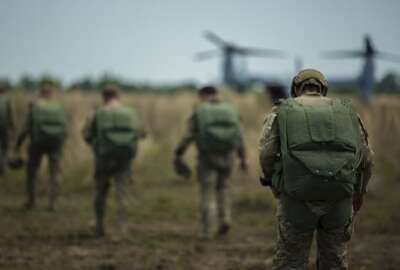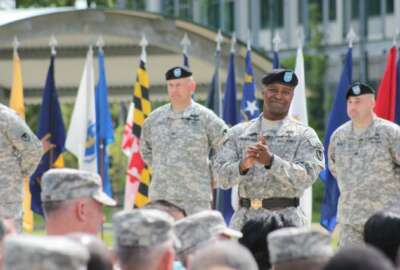
Army looks to new acquisition authorities, modest iterations as it builds tactical network
As the Army maps out a new architecture for tactical networks, it's trying to balance technical flexibility against a one-size-fits-all approach.
To listen to On DoD on your phone or mobile device, subscribe on PodcastOne or Apple Podcasts. The best listening experience on desktop can be found using Chrome, Firefox or Safari.
It’s been a little over a year since the Army decided to largely abandon the WIN-T program into which it had already invested $6 billion for tactical communications, declaring that “the network we have is not the network we need.”
Officials assert they’ve made significant progress in determining what soldiers actually do need in the intervening months. And even though it’s far from clear what the eventual architecture will look like, a few things have become apparent: the successor won’t be a single acquisition effort akin to the massive Warfighter Network Information-Tactical it’s replacing, it won’t be a single technical approach, not every Army formation will get the same gear and it certainly won’t happen all at once.
“That’s kind of what we’ve tried to do in the past, and it may not fit the way technology emerges now in the network space. It may not be the way of the future,” Maj. Gen. Peter Gallagher, the director of the Army’s network cross functional team said in an interview for Federal News Network’s On DoD.
Gallagher’s team is one of six the Army established in the leadup to the creation of the new Army Futures Command — the service’s new one stop shop for acquisition management — each representing the Army’s top modernization priorities.
He described his role as helping to define the “what” portion of the overall network modernization effort. But that effort is joined closely with the program executive office for command, control and communications-tactical (PEO-C3T), the same organization that led the WIN-T procurement, and whose acquisition professionals will determine exactly how to buy the new equipment.
Maj. Gen. David Bassett, who became the new PEO earlier this year, said whatever family of systems the Army settles on, with the goals of making its communications more resilient to near-peer adversaries and simpler for soldiers to use, will use an iterative approach.
“For a given unit, it’s impossible for the institutional Army to move fast enough to field to everyone all at the same time, for every commander that’s looking for kit to arrive within their tenure to change the way they fight,” he said. “And so I think we can get significantly better in terms of delivering capability. It means looking at the whole process, from how quickly can we get consensus and agree upon what we’re going to go buy, to how long it’s going to take to go test it, to how long it takes to make it operationally supportable and trainable. We’ve got to do all of those processes faster.”
To that end, Bassett said future network buys are likely to rely heavily on nontraditional acquisition authorities Congress has offered up to the Defense Department in recent years, including other transaction agreements (OTAs), and Section 804 of the 2016 National Defense Authorization Act, which permits the military services to bypass most of their usual acquisition processes when they’re conducting rapid prototyping and rapid fielding of new equipment.
It also means finding creative ways to repurpose systems the Army has already procured, he said.
“So where we’ve got a program that may have already run its course but has requirements that are still valid, we can introduce new capabilities through engineering changes without having to go through a whole new DoD 5000 process,” Bassett said.
“And on the contracting side, we’re putting in place larger contracts that allow us to do multiple deliveries under them to give us flexibility going forward, including the Common Hardware Systems contract that was just awarded. … We’re starting with contract vehicles that allow us to go significantly faster than if we had to start from scratch with a new solicitation.”
Army uses new structure to reorient R&D priorities
Part of the raison d’etre behind Army Futures Command was to help unify what the Army’s current senior leadership viewed as a disparate and disconnected modernization enterprise. When it comes to the network, the Army is using the new structure, in part, to reorient its research and development priorities.
Latest Defense News
“A lot of our effort over the last 11 months has been unpacking what the science and technology community inside the Army has been doing,” Gallagher said. “At Research, Development and Engineering Command (RDECOM) and the Communications, Electronics Research and Development Center (CERDEC), we’ve got a lot of smart engineers working on a lot of initiatives, but as we took a look at where we’re trying to go with the Army network modernization strategy and how it relates to the other modernization priorities, we’ve made serious recommendations of realignment of resourcing within that S&T portfolio to address the emerging threats and emerging capabilities. We’re trying to focus their efforts on capabilities that are going to be more promising to transition to either an existing program, or define a new program based on an emerging technology.”
In the meantime, Gallagher and Bassett said the Army has made some concrete progress in starting to field entirely new equipment in the aftermath of WIN-T’s phase-out.
One focus for the new gear has been the Army’s new Security Force Assistance Brigades, which have begun using radios that leverage waveforms the Army had not even considered as of two years ago. Those systems, previously proved out by special operating forces, are now under consideration for broader use in infantry, armored and Stryker brigades.
“There’s also an entirely new set of equipment for signal brigades, which the decision was made for less than a year ago. We’re fielding it right now,” Bassett said. “We’re long past the point of admiring the problem and moving forward with meaningful capability going into the hands of our soldiers. And I think as we look forward into the next year, as we begin to demonstrate this integrated tactical network in the infantry brigades, the Stryker brigades and the armor brigades, every one of those gives us the opportunity to introduce new technology, new design options and design choices.”
Copyright © 2025 Federal News Network. All rights reserved. This website is not intended for users located within the European Economic Area.
Jared Serbu is deputy editor of Federal News Network and reports on the Defense Department’s contracting, legislative, workforce and IT issues.
Follow @jserbuWFED





